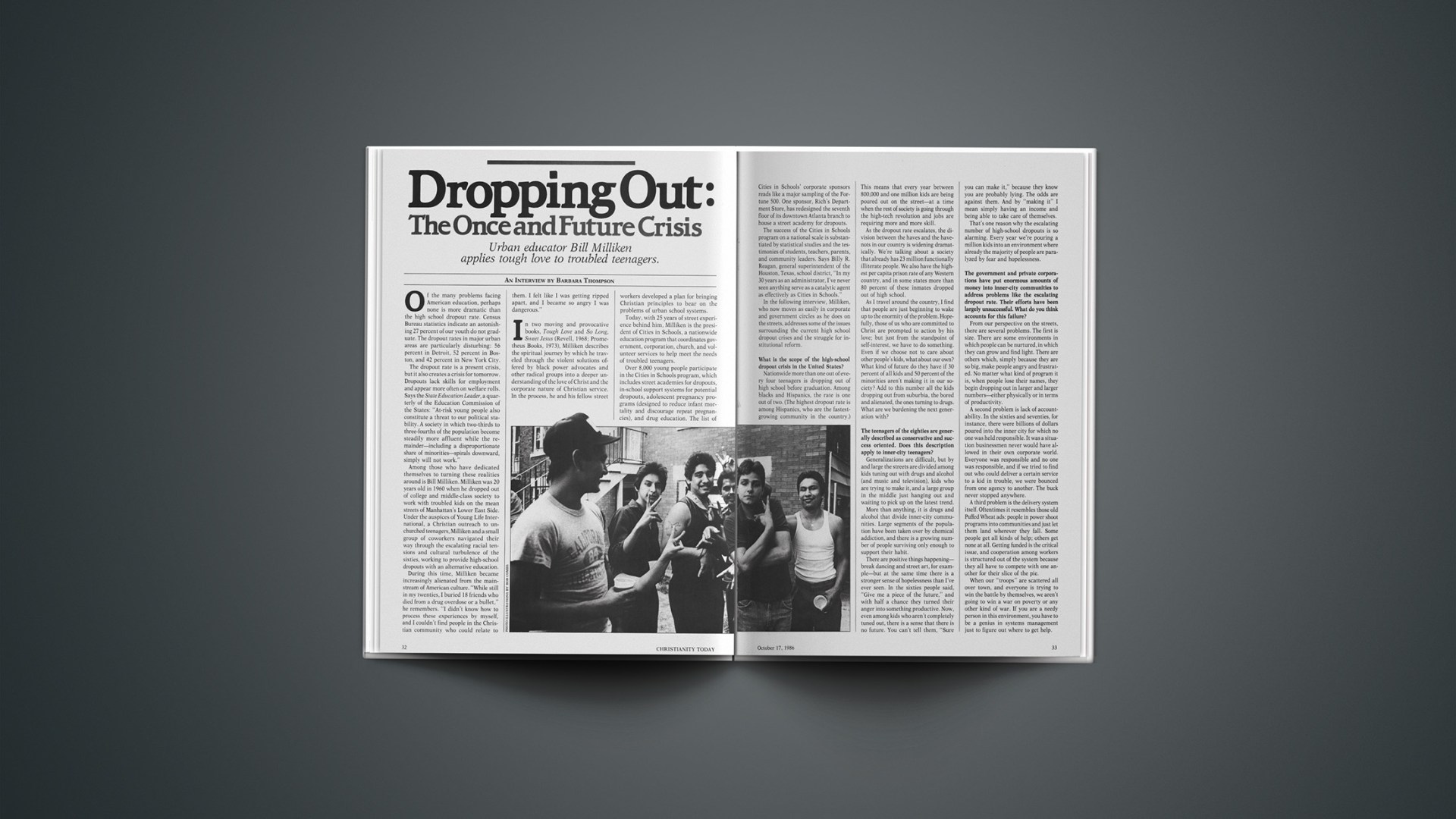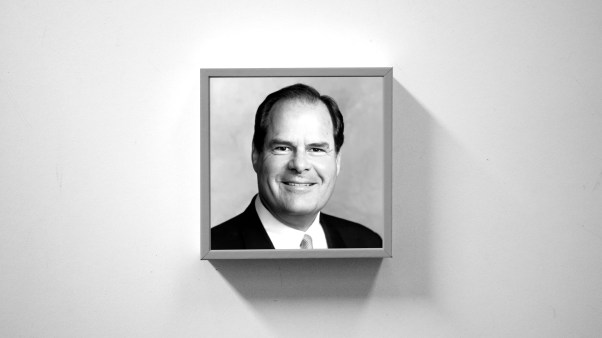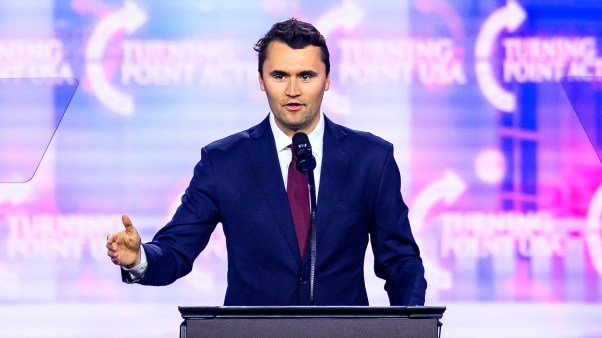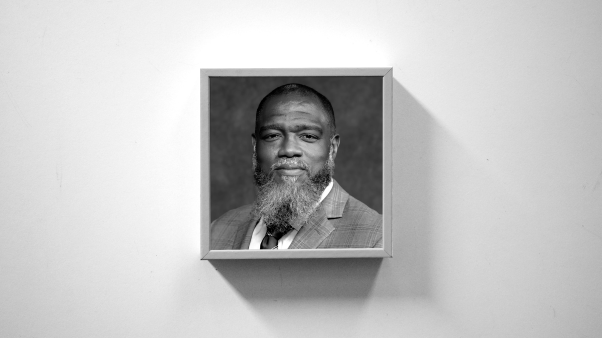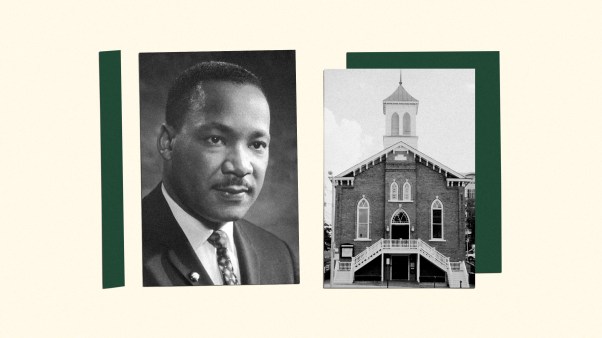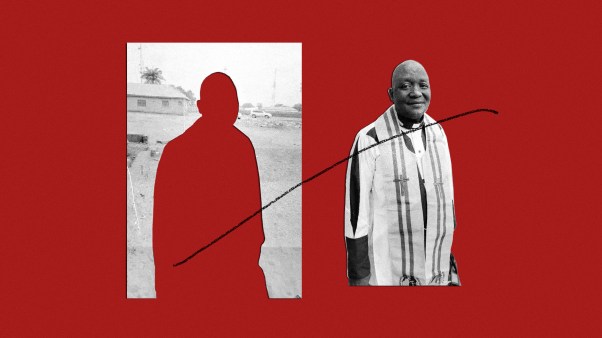AN INTERVIEW BY BARBARA THOMPSON1Barbara Thompson is a free-lance writer living in Brevard, North Carolina. Her latest book is Dyig for a Drink (Word, 1985), with Anderson Spickard, Jr.
Of the many problems facing American education, perhaps none is more dramatic than the high school dropout rate. Census Bureau statistics indicate an astonishing 27 percent of our youth do not graduate. The dropout rates in major urban areas are particularly disturbing: 56 percent in Detroit, 52 percent in Boston, and 42 percent in New York City.
The dropout rate is a present crisis, but it also creates a crisis for tomorrow. Dropouts lack skills for employment and appear more often on welfare rolls. Says the State Education Leader, a quarterly of the Education Commission of the States: “At-risk young people also constitute a threat to our political stability. A society in which two-thirds to three-fourths of the population become steadily more affluent while the remainder—including a disproportionate share of minorities—spirals downward, simply will not work.”
Among those who have dedicated themselves to turning these realities around is Bill Milliken. Milliken was 20 years old in 1960 when he dropped out of college and middle-class society to work with troubled kids on the mean streets of Manhattan’s Lower East Side. Under the auspices of Young Life International, a Christian outreach to unchurched teenagers, Milliken and a small group of coworkers navigated their way through the escalating racial tensions and cultural turbulence of the sixties, working to provide high-school dropouts with an alternative education.
During this time, Milliken became increasingly alienated from the mainstream of American culture. “While still in my twenties, I buried 18 friends who died from a drug overdose or a bullet,” he remembers. “I didn’t know how to process these experiences by myself, and I couldn’t find people in the Christian community who could relate to them. I felt like I was getting ripped apart, and I became so angry I was dangerous.”
In two moving and provocative books, Tough Love and So Long, Sweet Jesus (Revell, 1968; Prometheus Books, 1973), Milliken describes the spiritual journey by which he traveled through the violent solutions offered by black power advocates and other radical groups into a deeper understanding of the love of Christ and the corporate nature of Christian service. In the process, he and his fellow street workers developed a plan for bringing Christian principles to bear on the problems of urban school systems.
Today, with 25 years of street experience behind him, Milliken is the president of Cities in Schools, a nationwide education program that coordinates government, corporation, church, and volunteer services to help meet the needs of troubled teenagers.
Over 8,000 young people participate in the Cities in Schools program, which includes street academies for dropouts, in-school support systems for potential dropouts, adolescent pregnancy programs (designed to reduce infant mortality and discourage repeat pregnancies), and drug education. The list of Cities in Schools’ corporate sponsors reads like a major sampling of the Fortune 500. One sponsor, Rich’s Department Store, has redesigned the seventh floor of its downtown Atlanta branch to house a street academy for dropouts.
The success of the Cities in Schools program on a national scale is substantiated by statistical studies and the testimonies of students, teachers, parents, and community leaders. Says Billy R. Reagan, general superintendent of the Houston, Texas, school district, “In my 30 years as an administrator, I’ve never seen anything serve as a catalytic agent as effectively as Cities in Schools.”
In the following interview, Milliken, who now moves as easily in corporate and government circles as he does on the streets, addresses some of the issues surrounding the current high school dropout crises and the struggle for institutional reform.
What is the scope of the high-school dropout crisis in the United States?
Nationwide more than one out of every four teenagers is dropping out of high school before graduation. Among blacks and Hispanics, the rate is one out of two. (The highest dropout rate is among Hispanics, who are the fastest-growing community in the country.) This means that every year between 800,000 and one million kids are being poured out on the street—at a time when the rest of society is going through the high-tech revolution and jobs are requiring more and more skill.
As the dropout rate escalates, the division between the haves and the have-nots in our country is widening dramatically. We’re talking about a society that already has 23 million functionally illiterate people. We also have the highest per capita prison rate of any Western country, and in some states more than 80 percent of these inmates dropped out of high school.
As I travel around the country, I find that people are just beginning to wake up to the enormity of the problem. Hopefully, those of us who are committed to Christ are prompted to action by his love; but just from the standpoint of self-interest, we have to do something. Even if we choose not to care about other people’s kids, what about our own? What kind of future do they have if 30 percent of all kids and 50 percent of the minorities aren’t making it in our society? Add to this number all the kids dropping out from suburbia, the bored and alienated, the ones turning to drugs. What are we burdening the next generation with?
The teenagers of the eighties are generally described as conservative and success oriented. Does this description apply to inner-city teenagers?
Generalizations are difficult, but by and large the streets are divided among kids tuning out with drugs and alcohol (and music and television), kids who are trying to make it, and a large group in the middle just hanging out and waiting to pick up on the latest trend.
More than anything, it is drugs and alcohol that divide inner-city communities. Large segments of the population have been taken over by chemical addiction, and there is a growing number of people surviving only enough to support their habit.
There are positive things happening—break dancing and street art, for example—but at the same time there is a stronger sense of hopelessness than I’ve ever seen. In the sixties people said, “Give me a piece of the future,” and with half a chance they turned their anger into something productive. Now, even among kids who aren’t completely tuned out, there is a sense that there is no future. You can’t tell them, “Sure you can make it,” because they know you are probably lying. The odds are against them. And by “making it” I mean simply having an income and being able to take care of themselves.
That’s one reason why the escalating number of high-school dropouts is so alarming. Every year we’re pouring a million kids into an environment where already the majority of people are paralyzed by fear and hopelessness.
The government and private corporations have put enormous amounts of money into inner-city communities to address problems like the escalating dropout rate. Their efforts have been largely unsuccessful. What do you think accounts for this failure?
From our perspective on the streets, there are several problems. The first is size. There are some environments in which people can be nurtured, in which they can grow and find light. There are others which, simply because they are so big, make people angry and frustrated. No matter what kind of program it is, when people lose their names, they begin dropping out in larger and larger numbers—either physically or in terms of productivity.
A second problem is lack of accountability. In the sixties and seventies, for instance, there were billions of dollars poured into the inner city for which no one was held responsible. It was a situation businessmen never would have allowed in their own corporate world. Everyone was responsible and no one was responsible, and if we tried to find out who could deliver a certain service to a kid in trouble, we were bounced from one agency to another. The buck never stopped anywhere.
A third problem is the delivery system itself. Oftentimes it resembles those old Puffed Wheat ads: people in power shoot programs into communities and just let them land wherever they fall. Some people get all kinds of help; others get none at all. Getting funded is the critical issue, and cooperation among workers is structured out of the system because they all have to compete with one another for their slice of the pie.
When our “troops” are scattered all over town, and everyone is trying to win the battle by themselves, we aren’t going to win a war on poverty or any other kind of war. If you are a needy person in this environment, you have to be a genius in systems management just to figure out where to get help.
How have you addressed these problems in the Cities in Schools program?
We knew from experience that there were two ways to bring about change in our communities. We could love a few people on an individual level, or we could try to take on institutions and produce a model that others could duplicate. We chose an institutional approach and picked schools as our flagship because that’s what we knew the most about.
When kids are in trouble, it usually shows up first in school—through truancy, discipline problems, bad grades. As their problems grow more serious, they begin dropping out. Usually this happens about two years before they actually physically leave the school building. They hang around there because that’s where their friends are, or it’s warm, or they want to make drug pickups.
Cities in Schools targets these kids headed for trouble and surrounds them with a coordinated network of caring adults. For every 10 to 15 kids there is a counselor who visits in their homes, gets to know their friends, investigates family trouble, and helps them find the resources they need to cope with problems. Behind the counselors is a community support system, orchestrated by Cities in Schools and composed of local, state, and federal programs, corporations, and small businesses, churches, and private organizations and individuals.
These resource groups are brought into the school, and their staff members become part of the same team. Instead of competing with one another, people are working together to help kids learn. The unit is small enough that there is a genuine sense of community and accountability, and in this atmosphere it becomes possible for kids to get the help and education they need.
In working with troubled teenagers, what difference, if any, have you found between those young people who “make it” and those who don’t?
I’m frequently asked this question by people who have no idea what my spiritual background is, and they are surprised when I say the key is two verses of Scripture. The first is “You get your life by giving it away.” We’ve all been taught the opposite by the media. We, and our kids, are bombarded by the idea that we get life by grabbing for it, by doing all we can to look out for ourselves.
The second verse is “It’s more blessed to give than to receive.” When I first read these words, they seemed paternalistic. What came to mind was the do-gooders who trap people in slavery by giving handouts without any kind of relationship. But the more I thought about it, the more I saw these words of Jesus as the basis for bringing about change in kids’ lives. If it really is more blessed to give than to receive, then everyone ought to have the chance. If we come to kids with the attitude that they have nothing to give us, that they are losers, then they are already dead.
The breakthrough comes when some adult enters the valley of the shadow of adolescence with them, and walks through the brokenness, the anger and hostility, to find out what they have to give. Maybe it’s something as simple as working at a department store and getting paid for it. Or tutoring a younger brother or sister who is behind in school.
Having said this, there are some kids who aren’t going to make it. When I first came to the streets, I was very naïve, and I thought anyone with the right opportunity could break out of a dead-end life. But there are kids for whom there are simply too many bricks in the wall. They’ve been hurt too long, and while some day in eternity they may find wholeness and healing, it probably isn’t going to happen in this life.
In the Cities in Schools program, what has been the result when teachers, counselors, social workers, and others are held accountable for the job they perform?
More people than you might guess are excited and find new growth. A smaller number can’t wait to get out. Some of these are people who took their jobs because there wasn’t another one available, and at a certain point there has to be a weeding-out process. We encourage such people that there is dignity in other jobs, but we let them know that they can’t continue to be involved in a professional way with the lives of our kids.
Any time people begin working together there will be other people who feel threatened because they don’t have as much power as they once did. But some people are simply slower to catch on to new ideas. They are not bad people, and you can’t win their hearts by pounding away at them. You just need to step back and give them time to think through the issues.
In recent years social workers and other individuals who deliver services to the poor have come to be seen as highly ineffective. Has this been confirmed by your experience with Cities in Schools?
No. At one time I looked at all social workers and bureaucrats in the welfare system as enemies; now I see that most of them start out with the same commitment as anyone else, but they get terribly abused along the way. It’s easy to single them out as the source of the problem, to say, “Look, we put all those people out there and nothing happened so it must be their fault.” The problem is that they are structured wrong. Their effectiveness depends on teamwork and cooperation, but they burn out when they are constantly having to fight each other and the enormous system in which they work.
The way the government approaches the problems of poverty amounts to rearranging the deck chairs on the Titantic. One group comes in and shifts things here and there; then the next group does something else. But the boat is still sinking. There are still poor people and they still have problems. How are we going to deliver any services to them if we get rid of all the workers?
There is a growing consensus that the welfare system has not only not helped the poor, but has aggravated their problems. As a result, there is currently a strong reaction in our country against the whole system. What is your view of this situation?
A lot of people get hurt by arbitrary cuts in the welfare system and are returned to the poverty cycle. But nobody asks: Is this an effective way to solve or alleviate the problems of the poor? What do people in the local community think? There isn’t enough time to evaluate anything, because every four years sweeping changes are made. And every six months someone wants to take the tree out of the ground to see if the roots are growing.
We never would have made it to the moon if we had approached space travel in the same way we decide matters concerning the poor, NASA spent millions on failure, but our national leaders never decided, “It can’t be done; let’s give up.” Their attitude was “So we did some stupid things—let’s learn from our mistakes and do better next time.”
When it comes to the poor, the baby goes out with the bathwater. But the truth is, everything we are talking about—small units, accountability, cooperation—can be structured into large organizations. If it wasn’t possible, 90 percent of the corporations never would have made it. We need to figure out how to clean up our systems and make them work. And if people are ripping them off, let’s find out how to stop them.
When you first began working on the streets of the Lower East Side you were profoundly alienated from “the system” and those who worked within it. What brought about the change in your perspective?
In my greatest moments of anger on the street, I was very uncompromising. I was sure I was right about everything. But if you get broken enough, proved wrong enough, then you realize you don’t know as much as you think.
Several years ago I was on an airplane, and the man sitting next to me was from the Joint Chiefs of Staff. I told him I was arrested outside his place [the Pentagon], and he invited me to come see it from the inside. I went, and it was part of the process by which I learned I couldn’t simply dismiss people I disagreed with as terrible human beings. I still feel that as Christians we are called by Christ to lay down arms, but I understand the other side’s position better.
Some of my radical friends take offense because I hang out with folks from the White House or corporations or the music world. Then again, some of these well-to-do friends would take offense at life on the street. I grew up desperately needing other people’s approval, but what I’ve discovered is that I have to hold on to my basic relationship with Christ, and then do what I can and go where I can in both worlds. I want to walk into the White House as long as they will let me, and I want to love those folks there as deeply as I do my friends on the street.
The truth is you can’t love kids and hate the people whom you’re asking for money. In the long run, this produces a poison for the whole system. I tell people if they can’t love the folks who provide the resources, then they need to get out of this line of work. Otherwise, they will be in danger of becoming hypocrites.
What particular personal lessons have you learned in the past few years?
As I get older, I am amazed how much ideologues on both the Right and Left resemble one another. There is the deep-seated anger, and the conviction that they alone are right. I am less sure about most things than I have ever been in my life. All I know is that when I wake up in the morning, I thank God that the world is still here, that I can serve a little, love a little, hurt a little. I have no grandiose ideas about saving the world anymore—even though I always still charge ahead, and need to be reminded every 20 minutes or so that it is faithfulness and not success that matters.
I also have a deeper appreciation for what Jesus meant when he said that the wheat and the tares are growing together. Everything is intertwined; it’s not in neat packages. Sometimes I get up in the morning, and all I see is weeds. It’s overwhelming how truly terrible and hopeless everything looks. Then I have to realize once again that the weeds are not the whole story. I have to trust that in God’s economy his kingdom is being built. Sure, there are monsters, demons, and ghettos. But what about those plants growing over there? What about these flowers in our midst?
I’m personally seeing more beautiful things happen now than at any other time in my life. I was in Appalachia recently, and I went wondering what I could possibly have to say to people whose background was so radically different from my own. Then I discovered we shared many of the same problems and experiences. When I left, I was hugging people good-bye who once would have dismissed me as a liberal white boy from the North, just as I would have dismissed them as racist rednecks.
In the midst of all the insanity around us, people are reaching out and talking with one another. New structures and relationships are being formed. And our task is to choose to put our trust in God rather than chariots, to believe that somehow our little stitch in the garment is part of his kingdom.
“The Only Failure Is Not to Try”
Latania Smith2Not her real name. was 15 months old when she was abandoned by her mother. She was raised by her grandmother in a middle-class Philadelphia neighborhood, where she attended parochial schools and was a straight-A student.
At the age of 13, Latania began smoking marijuana. “I don’t know why I started using drugs,” Latania says. “But everyone was doing it. I mean everyone. My grandmother kept going in and out of the hospital, and I could feel she was going to die. She had been my mother for as long as I could remember, and I wasn’t ready for her to go yet. Maybe I used drugs to escape.”
When Latania was 14, her grandmother died. Latania moved in with relatives and drifted through a string of public housing projects. At the end of ninth grade, she dropped out of school. “Every day was the same,” Latania remembers. “I woke up in the morning and got high. Then I sold drugs. And I, worried all the time about getting jumped, where I was going to get money, where I would sleep at night.”
Latania smoked marijuana and angel dust while using cocaine and occasionally LSD. As her health deteriorated, she was repeatedly hospitalized. After one life-threatening episode, and with encouragement from her boyfriend, she began to re-evaluate the direction of her life.
“I realized I wasn’t ever going to be anything if I stayed with my relatives,” Latania recalls. “They sat at home all day, with their babies, doing drugs and waiting for the welfare check. I didn’t want that. I felt deep inside that God had kept me alive for some reason, that there was something left for me to do.”
At the age of 16, on her own initiative, Latania moved to Atlanta. For a brief time, she lived with her mother (“It didn’t work out,” Latania says matter-of-factly), and it was here she learned about the Cities in Schools academies for high-school dropouts. After an interview at Saint Luke’s Academy, located in an Episcopal church, Latania was given a basic skills test and placed in the school’s highest achievement group.
“I was afraid at first,” Latania says. “The students seemed like losers to me, because I knew they were all dropouts. But after a few days, I was part of the family. And I began to respect people here. They’ve made some mistakes, but they’ve had the courage to pick up the pieces and try again.”
Today Latania is studying chemistry, math, social science, and English at Saint Luke’s, under the supervision of a small corps of teachers paid by the Atlanta public school system. She attends a weekly SAT preparation class, a group drug-counseling session, and she is actively involved in Young Life.
Latania is also a member of the Leadership Group, a select group of 40 students drawn from the four Cities in Schools learning centers for dropouts in Atlanta. The group meets weekly, sponsors special speakers, and attends weekend retreats.
“We are learning to set goals and reach them,” Latania explains. “We help each other turn our bad self-images and negative attitudes into something positive. We’re the future leaders of tomorrow and need to learn how to handle ourselves.”
Latania speaks of her own future with the mixture of confidence and diffidence that characterizes teenagers preparing to launch themselves in life. But she also speaks with the realism and toughness that is the peculiar heritage of inner-city teenagers.
“Our counselors tell us we can be anything we want to be as long as we are prepared to sacrifice and work hard. I want to be a lawyer, and I plan to go to a college with a good English and political science program.
“I also want to be a Supreme Court judge. People look at me and say, ‘You can’t do that!’ Why can’t I? If lean be a lawyer, I can be a judge. But if I do my best and fail, I won’t feel bad. The only failure is not to try.”
For Latania Smith, it is a long way from teenage dreams to the Supreme Court. But perhaps it is no further than the distance she has already traveled—from the life-crippling housing projects of inner-city Philadelphia to the hope-filled classrooms of Saint Luke’s Academy.
By Barbara Thompson.

